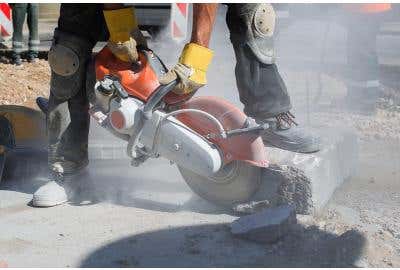How to Protect Yourself from Respirable Crystalline Silica on the Job Site


Millions of workers are exposed to respirable crystalline silica – a basic component found in soil, sand, granite and other common construction materials – each day on the job. Materials that contain crystalline silica are not hazardous unless they are disturbed, creating a dust which easily penetrates the lung. When inhaled, silica dust can cause serious, even irreversible, health risks. Recently, OSHA released updated regulations to help keep workers safe on the job. Below is an overview of who is at risk for exposure and how to protect yourself if you may be at risk.
Who's At Risk for Crystalline Silica Exposure
Respirable crystalline silica has many different forms, and it’s important to be aware of all of them. The most common form is quartz, but it’s also seen as cristobalite and tridymite. Particles can be released into the work area while chipping, cutting, drilling and grinding materials that contain them. Those materials include:
- Concrete
- Masonry
- Sandstone
- Rock
- Paint
- Abrasives
- Mortar
- Plaster
- Shingles
- Soil
Construction workers are most at risk for coming into contact with respirable crystalline silica. But people in the General Industry sector, including brick manufacturing and hydraulic fracturing industries, are at risk as well. Even janitors and security personnel working in the vicinity need to be aware of the hazards of exposure and practice proper safety measures.
Preventing Illness Caused by Respirable Crystalline Silica
There are several serious diseases associated with inhalation of respirable crystalline silica. Workers who have been exposed to silica dust have developed lung cancer, chronic obstructive pulmonary disease (COPD), kidney disease and silicosis. Some conditions, like silicosis, don’t have a cure, which is why training and prevention are so important for worker safety.
OSHA suggests some ways to reduce exposure and prevent illness, including:
- Use of surfactants or wet methods to suppress dust
- Vacuum dust collection (VCD)
- Respiratory protection devices
- Ventilated booths
- Operator isolation
- Fans (supplemental only)
- Medical surveillance and periodic exams
- Air monitoring
- Hazard warning signage
- Recordkeeping
- Proper housekeeping procedures
Respirable Crystalline Silica Safety Training
Training courses are a great option to increase awareness about what respirable crystalline silica is and its effects on workers. These courses can teach you everything you need to know about how to correctly follow OSHA’s regulations and ensure maximum health and safety.
If you’d like to educate yourself more about respirable crystalline silica, sign up for one of these top courses today:
- Respirable Crystalline Silica Awareness in Construction
- Respirable Crystalline Silica Awareness in General Industry
You can fully complete the course online and earn CEU credit. The interactive course material goes over all the basics and explains how to understand and access OSHA’s new §1926.1153 and §1910.1053 requirements, so that workers, supervisors and managers can all stay safe on the job site.

